This document discusses the historical development of blackbody radiation and the birth of modern physics. It describes how the ultraviolet catastrophe paradox in classical physics led Planck to propose quanta of energy, called photons, and statistics to describe blackbody radiation. Although Planck and Einstein saw quanta as a mathematical trick rather than physical reality, it opened the door to quantum mechanics. The document questions whether classical physics could explain blackbody radiation without departing from determinism and continuity.
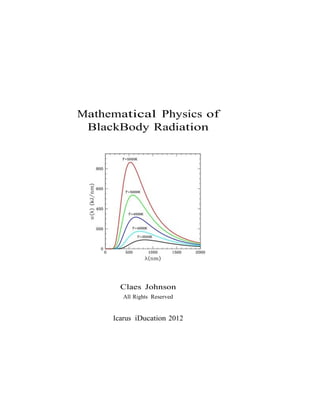





![Preface
The mystery of blackbody radiation triggered the birth of modern physics
in 1900, when Planck in an “act of despair” invented the idea of a smallest
quantum of energy, which Nature assembles according to laws of statistics
with high frequency high energy waves being rare, because they require many
quanta. But Planck viewed quanta to be merely a mathematical trick to
resolve a scientific deadlock of classical wave mechanics, a trick without real
physical meaning.
Nevertheless, Einstein used a similar idea of “quanta of light” later called
photons, to come up with a (simple) formula for the photoelectric effect,
which gave him the Nobel Prize in 1921; for the formula but not its deriva-
tion based on quanta, because Swedish scientists did not believe in any reality
of light quanta or light particles. In late years Einstein confessed that nei-
ther he believed in light quanta, but the reservations of the inventors
were overwhelmed by the snowball of quantum mechanics starting to roll
in the
1920s.
Hundred years later blackbody radiation is back at the center of discus-
sion, now as the cornerstone of climate alarmism based on the idea of atmo-
spheric “backradiation” from so-called “greenhouse gases” causing ”global
warming”. The weakness of this cornerstone is exposed in the book Slaying
the Sky Dragon: Death of the Greenhouse Gas Theory [19] using arguments
from this book.
The basic idea is to use a classical deterministic continuum wave me-
chanics combined with a new feature of finite precision computation, which
Nature is supposed to use in analog form and which can be modeled by a
computer in digital form. This leads to a form of computational blackbody
radiation with close connections to the computational thermodynamics and
the 2nd Law of thermodynamics developed in the book Computational Ther-
modynamics [22].
1](https://image.slidesharecdn.com/ambsblack-140606112644-phpapp02/85/black-7-320.jpg)
![2 CONTENTS
Statistical models based on microscopic randomness were introduced in
thermodynamics by Boltzmann in order to prove and explain the 2nd Law,
which seemed impossible usinng classical deterministic continuum models.
Planck used the same ”trick” to avoid the seemingly unavoidable “ultra-
violet catastrophe” in classical deterministic continuum wave mechanics of
blackbody radiation. However, it is in principle impossible to directly test
the validity of a model of microscopic randomness, since that would require
in microscopics of microscopics. On the other hand, the effect of finite pre-
cision computation (which can be viewed as a testable rudimentary form of
statistics) can in be determined which makes model verification possible in
principle.
The present book can be read as a more detailed account of my arguments
in [19] related to radiation, but can also be seen as an attempt to resuscitate
classical deterministic continuum mechanics (as opposed to statistical par-
ticle mechanics) from the ‘ultraviolet catastrophe” by fusing it with a new
concept of finite precision computation.
Stockholm in November 2011
Claes Johnson](https://image.slidesharecdn.com/ambsblack-140606112644-phpapp02/85/black-8-320.jpg)





![8 CHAPTER 1. BLACKBODY RADIATION
used by Planck in his original proof. Finite precision computation models
physics as an analog computational process with input data being trans-
formed to output data, which can be simulated by digital computation. The
idea of finite precision computation is also used in an alternative theory of
thermodynamics in the form of Computational Thermodynamics [22], with-
out any statistics.
I follow up in Many-Minds Quantum Mechanics [3] following the original
idea of Schr¨odinger to view the Schrodinger wave equation as a model
of interacting electrons and atomic in the form of a coupled set wave
functions without any need of statistical interpretation. The idea of
many-minds is also also used in a new approach to relativity [4] without
the paradoxes of Einsteins special theory of relativity.](https://image.slidesharecdn.com/ambsblack-140606112644-phpapp02/85/black-14-320.jpg)








![kT kT
Chapter 4
Planck-Stefan-Boltzmann Laws
The spectral density of black body radiation ... represents something
absolute, and since the search for the absolutes has always appeared
to me to be the highest form of research, I applied myself vigorously
to its solution. (Planck)
4.1 Planck’s Law
The particle nature of light of frequency ν as a stream of photons of energy
hν with h Planck’s constant, is supposed to be motivated by Einstein’s
model of the photoelectric effect [] viewed to be impossible [31] to explain
assuming light is an electromagnetic wave phenomenon satisfying Maxwell’s
equations. The idea of light in the form of energy quanta of size hν was
introduced by Planck [5] in “an act of despair” to explain the radiation
energy Rν (T ) emitted by a blackbody as a function of frequency ν and
temperature T , per unit frequency, surface area, viewing solid angle and
time:
2k
Rν (T ) = γT ν 2
θ(ν, T ), γ
=
with the high-frequency cut-off factor
, (4.1)
c2
θ(ν, T ) =
hν
kT
hν
e kT − 1
, (4.2)
where c is the speed of light in vacuum, k is Boltzmann’s constant, with
θ(ν, T ) ≈ 0 for hν
> 10 say and θ(ν, T ) ≈ 1 for hν
< 1. Since h/k ≈ 10−10
,
17](https://image.slidesharecdn.com/ambsblack-140606112644-phpapp02/85/black-23-320.jpg)




![for thermodynamics presented in [22].
The photon is considered to be a ”particle” with no mass and no charge,
but to observe individual photons appears to be extremely difficult. In fact,
the existence of photons seems to be highly hypothetical with the main pur-
pose of explaining black-body radiation and the photoelectric effect. If ex-
planations of these phenomena may be given using classical wave mechanics,
maybe the existence of photons as particles without both mass and charge
may be seriously questioned, including statistical particle mechanics, as Ein-
stein himself did during the later half of his life [16, 10, 11, 12, 14, 18].
Figure 4.5: Wien’s Displacement Law.
The scientific price of resorting to statistical mechanics is high, as was
clearly recognized by Planck and Einstein, because the basic assumption of
statistical mechanics of microscopic games of roulette seem both scientifically
illogical and impossible to verify experimentally. Thus statistical
mechanics runs the risk of representing pseudo-science in the sense of Popper
[?] because of obvious difficulties of testability of basic assumptions.
The purpose of this note is to present an alternative to statistics for black-
body radiation based on finite precision compuation in the form of General
Galerkin G2. We also extend to include aspects of photo-electricity and the
Compton effect.](https://image.slidesharecdn.com/ambsblack-140606112644-phpapp02/85/black-28-320.jpg)




![4.7. TOWARDS ENIGMA RESOLUTION 27
4.7 Towards Enigma Resolution
We shall find that finite precision computation, in G2 appearing from resid-
ual stabilization, as a small-coefficient viscosity acting on higher derivatives
of the state function, makes it possible to avoid the seemingly unsurmount-
able difficulties hampering classical continuum mechanics in the late 19th
century, including “d’Alembert’s paradox” of turbulent fluid mechanics, the
“reversibility paradox” of the 2nd Law of thermodynamics and the “ultra-
violet catastrophe” of blackbody radiation. The difficulties arise from unre-
solved microscopics in macroscopic continuum models and the only way out
was believed to be by modeling the microscopics by statistics of pointlike
particles, and this became the mantra of 20th century physics.
However, a medication with microscopic particle statistics comes along
with several side effects, so severe that e.g. Einstein and Schr¨odinger
refused to accept it, and thus a return to deterministic continuum models
would seem desirable, if only the paradoxes and catatsrophies can be dealt
with in a resonable way. We have shown in [21] that finite precision
computation allows a resolution of d’Alembert’s paradox and several of the
mysteries of turbulent fluid mechanics, as well as a formulation of the 2nd
Law without entropy statistics in [22] , and in this book we use the same
general approach for the wave mechanics of radiation.
One can view deterministic finite precision computation as a primitive
form of statistics, so primitive that the side effects do not show up, while the
positive effect remains.](https://image.slidesharecdn.com/ambsblack-140606112644-phpapp02/85/black-33-320.jpg)


![30 CHAPTER 5. PLANCK/EINSTEIN TRAGEDY
diation associated with it, and could emit radiation only in
complete units.
• It could never emit a fraction of a unit, so that radiation was assumed
to be atomic. Such an assumption naturally led to very different results
from the Newtonian mechanics, but Planck was able to show that nature
sided with him. His theory predicted the observed emission of radiation
from a hot body exactly. Planck described his units of radiation as
quanta.
• The amount of energy in any unit depended on the vibrator from which
the unit came being equal to the frequency ofits vibrations multiplied
by a constant h, which is generally known as Planck’s constant; this
has proved to be one of the fundamental constants of the universe like
the charge on an electron or the mass of a proton. Through all the
changes which the quantum theory has experienced and they are
many h has stood firm as a rock, but we now associate it with
radiation rather than with vibrators.
5.2 Max Planck
We cite from [5]:
• We shall now derive strange properties of heat radiation described by
electromagnetic wave theory.
• We shall assume that the radiation in one direction is completely inde-
pendent of the radiation in a different direction, even opposite.
• Zur radikalsten Affassung neigt J.J Thompson und A. Einstein, welche
glauben, das die Fortpflanzung der elektromagnetischen Wellen nicht
genau nach den Maxwellshen Feldgleichungen, sondern nach gewis-
sen Energiequanten hν erfolgt. Ich meine dagegen, dass man einst-
weilen noch nicht genotig ist, so revolutionar vorzugehen, sondern das
mann damit auskommen du¨rfte, die Bedeutung des
Energiequantums hν lediglich in den Wechselwirkungen zu suchen,
mit denen die Res-
onatoren einander beeinflussen. Eine definitive Entscheidigung u¨be
r
diese prinzipiellen Fragen k¨onnen aber erst weiter Erfahrungen
brin- gen.](https://image.slidesharecdn.com/ambsblack-140606112644-phpapp02/85/black-36-320.jpg)






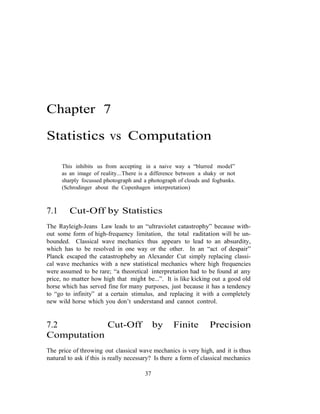
![38 CHAPTER 7. STATISTICS VS
COMPUTATION
without the ultraviolet catastrophy? Can a cut-off of high frequencies be
performed without an Alexander cut-off ?
We believe this is possible, and it is certainly highly desirable, because
statistical mechanics is difficult to both understand and apply. We shall
thus present a resolution where Planck’s statistical mechanics is replaced
by deterministic mechanics viewing physics as a form of analog computation
with finite precision with a certain dissipative diffusive effect, which we model
by digital computational mechanics coming along with a certain numerical
dissipation.
It is natural to model finite precision computation as a viscous dissipative
effect, since finite precision means that small details are lost as in smoothing
by damping of high frequencies which is the effect of viscous dissipation.
We consider computational mechanics in the form of the General
Galerkin (G2) method for the wave equation, where the dissipative
mechanism arises from weighted least squares residual stabilization [21]. We
shall first consider a simplified form of G2 with least squares stabilization of
one of the residual terms appearing as a viscosity acting only on high
frequencies. We then comment on full G2 residual stabilization.
Figure 7.1: A blackbody acts like a censor or high-pass filter which transforms
coherent high-frequency high-interest information into incoherent
noise, while it lets low-frequency low-interest information pass through.](https://image.slidesharecdn.com/ambsblack-140606112644-phpapp02/85/black-44-320.jpg)
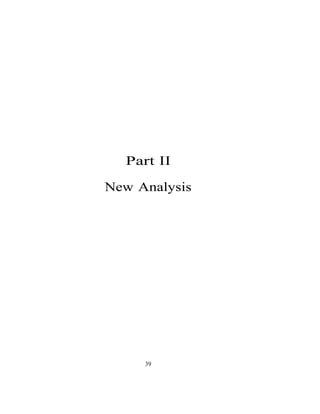

![u
u
Chapter 8
Wave Equation with Radiation
There are no quantum jumps, nor are there any particles. (H.D. Zeh
[44])
8.1 A Basic Radiation Model
We consider the wave equation with radiation, for simplicity in one space
dimension assuming periodicity: Find u = u(x, t) such that
u¨ − u′′
− γ
...
= f, −∞ < x, t < ∞ (8.1)
where (x, t) are space-time coordinates,
v˙
= ∂v
, v′
= ∂v
, f (x, t) models
∂t ..∂.x
forcing in the form of incoming waves, and the term −γ u models outgoing
radiation with γ > 0 a small constant.
This models, in the spirit of Planck [5] before collapsing to statistics of
quanta, a system of resonators in the form of a vibrating string absorbing
energy from the forcing f of intensity f 2
and dissipating energy of intensity
γu¨2
as radiation, while storing or releasing vibrational (heat) energy in
energy balance.
The wave equation (8.1) expresses a force balance in a vibrating system
of charged particles with u representing the displacement from a reference
...
configuration with
u˙
velocity and u¨ accelleration, and −γ u represents the
Abraham-Lorentz recoil force from an accellerating charged particle [43]. En-
ergy balance follows from the force balance by multiplication by
u˙
followed
by integration, which gives the dissipated radiated energy γu¨2
by
integration by parts (from −γ
...
multiplied by u˙ ), referred to as Lamoursformula [43].
41](https://image.slidesharecdn.com/ambsblack-140606112644-phpapp02/85/black-47-320.jpg)

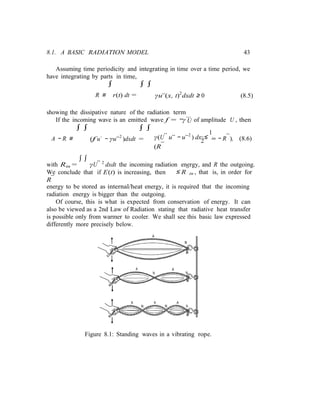




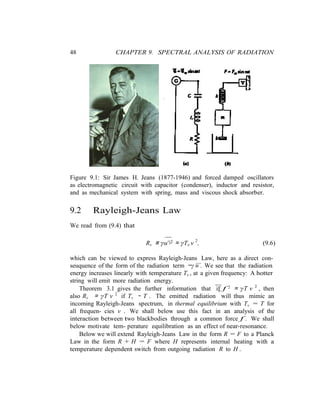






![10.3. FOURIER ANALYSIS OF NEAR-RESONANCE 55
The above discussion concerns time-periodic (equilibrium) states attained
after a transient start-up phase, with the forcing now F in-phase with the
velocity u˙ , in contrast to out-of-phase in equilibrium.
The discussion in this note connects to apects of wave vs particle modeling
of light and sound [20, 15, 16, 23, 24, 5].
Figure 10.1: A Steinway Grand Piano as a set of strings over a resonating
board.
10.3 Fourier Analysis of Near-Resonance
Although (10.1) is a maybe the most studied model of all of physics, it
appears that the phenomenon of near-resonance has received little attention.
As above we use Fourier transformation in t of (10.1), writing
to get
u(t) =
∫ ∞
uˆ(ω)eiωt
dω,
with
−∞
1
uˆ(ω) =
2π
∫ ∞
u(t)e−iωt
dt,
−∞
(−ω2
+ ν 2
)uˆ(ω) + iγωuˆ(ω) = fˆ(ω).](https://image.slidesharecdn.com/ambsblack-140606112644-phpapp02/85/black-61-320.jpg)




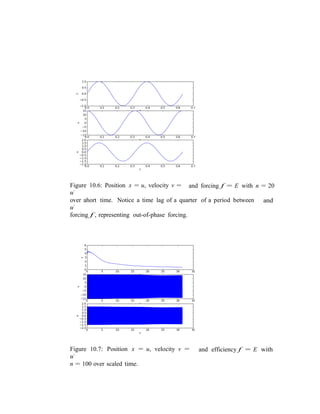








![11.9. RADIATIVE COOLING 69
11.9 Radiative Cooling
If the forcing f is terminated then the blackbody will start cooling according
to ∫ ∫
E˙ dt = − γu¨2
dxdt = −R (11.15)
with E defined by (8.3). With E ∼ T 2
and R ∼ T 4
, this gives assuming
f (t) = 0 for t > 0
E(t) =
1
1 + C t
E(0) (11.16)
with C a positive constant, and thus the following cooling curve
1
T (t) = T (0)(1 + C t)− 2 . (11.17)
For an individual frequency ν we have since Eν = Tν
E˙ ν = −Rν ≈ −γν 2
Tν = −γν 2
Eν (11.18)
indicating a decay of Eν = Tν according to exp(−γν 2
t) with faster decay for
higher frequencies. To maintain that Tν = T for all ν , requires near-
resonance with tendency towards thermal equilibration.
Note that with the version of Stefan-Boltzmann’s Law of statistical me-
chanics, the internal energy E is proportional to T (and not T 2
as above),
which gives a somewhat different cooling curve
1
T (t) = T (0)(1 + C t)− 3 , (11.19)
with less rapid decay with time. Experiments [40] appear to favor (11.17)
before (11.19), see Fig. 11.2.
11.10 Interaction by Shared Force
Note that we consider the intercation of two blackbodies to be established
through a (non-zero) shared force f . The above case of cooling with f =
0 thus represents an extreme case with one the of the bodies kept at 0 K.
The normal case is thus f = 0 described by Planck’s Law as R + H =
F which covers interaction of two blackbodies indexed by 1 and 2 as R1 + H1
= R2 + H2.](https://image.slidesharecdn.com/ambsblack-140606112644-phpapp02/85/black-75-320.jpg)







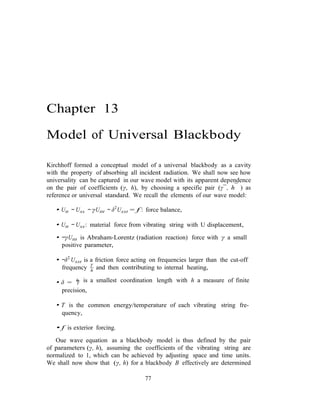


![80 CHAPTER 14. RADIATIVE HEAT TRANSFER
2
1
which expresses Stefan-Boltzmann’s Law for the radiative heat transfer from
a one body in radiative contact with a body of lower temperature. We see
that the heat transfer has a contribution from frequencies below the cut-off
T1 for B1 as the difference γ(T2 − T1)ν 2
and one contribution from freqencies
above T1 as γT2ν 2
.
We can view the Stefan-Boltzmann Law (14.3) as form of Fourier Law
stating a positive rate heat transfer from a higher temperature T2 to a lower
temperature T2. In differentiated form this law can be expressed as
Q12 ≈ 4σT 3
(T2 − T1) for some T1 < T < T2 (14.4)
which mimics a Fourier Law expressing heat flow as being proportional to a
temperature gradient.
14.2 Non-Physical Two-Way Heat
Transfer
Notice the requirement in (14.3) that T2 > T1 . In the literature one finds the
law without this requirement in the form
Q12 = σT 4
− σT 4
, Q21 = σT 4
− σT 4
= −Q12 (14.5)2 1 1 2
where Q21 is the heat transfer from B1 to B2 as the negative of Q12 .
This form has led to a misinterpretation of Stefan-Boltzmann’s Law as
expressing heat transfer from B2 to B1 of size σT 4
balanced by a transfer
−σT 2
from B1 to B2, as if two opposing transfers of heat energy is taking
place between the two bodies with their difference determining the net flow.
Such a misinterpretation was anticipated and countered in Stefan’s orig-
inal article [42] from 1879:
• The absolute value the heat energy emission from a radiating body can-
not be determined by experiment. An experiment can only
determine the surplus of emission over absorption, with the absorption
determined by the emission from the environment of the body.
• However, if one has a formula for the emission as a function of tem-
perature (like Stefan-Bolzmann’s Law), then the absolute value of the
emission can be determined, but such a formula has only a hypothetical
meaning.](https://image.slidesharecdn.com/ambsblack-140606112644-phpapp02/85/black-86-320.jpg)





![86 CHAPTER 16. 2ND LAW OF
RADIATION
16.2 Mystery of 2nd Law
The 2nd Law of thermodynamics has posed a mystery to science ever since it
was first formulated by Clausius in the mid 19th century, because it involve
the mysterious concept of entropy which is postulated to never decrease by
some mysterious mechanism.
In [22] I state and prove a 2nd Law of thermodynamics in terms of kinetic
energy, heat energy, work and turbulent dissipation, without reference to
entropy.
16.3 Stefan-Boltzmann Law as 2nd Law
Similarly, the new derivation of Planck’s and Stefan-Boltzmann’s laws of this
book proves a 2nd law for radiative transfer between two blackbodies without
any reference to entropy, which can be expressed as follows
Q12 = σ(T 4
− T 4
) if T1 > T2 (16.1)1 2
where T1 is the temperature of the blackbody 1 and T2 that of blackbody 2,
assuming that T1 > T2 , and Q12 > 0 is transfer of heat energy from 1 to 2.
The transfer of energy is thus from hot to cold.
The equality (16.1) is often written in the form
Q12 = σT 4
− σT 4
(16.2)1 2
without specifying that T1 > T2 and is then interpreted as expressing transfer
of heat energy of size σT 4
from 1 to 2 and a transfer of σT 4
in the opposite1 2
direction from 2 to 1. But this interpretation lacks physical rationale and
results from a purely formal algebraic operation of splitting the one term
in (16.1) into the differenec of two terms in (16.2). This is the origin of
the ”backradiation” underlying climate alarmism which thus lacks physical
reality.](https://image.slidesharecdn.com/ambsblack-140606112644-phpapp02/85/black-92-320.jpg)






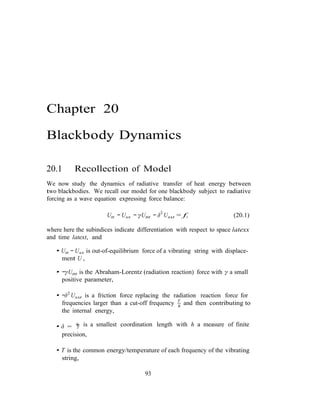

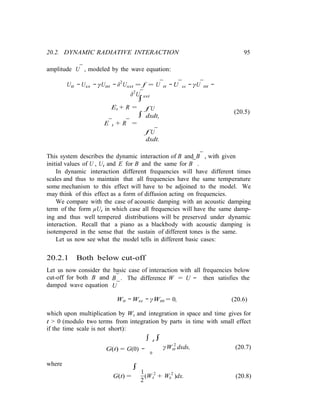

![h
T
Chapter 21
The Photoelectric Effect
21.1 Nobel Prize to Einstein
Einstein was awarded the Nobel Prize in 1923 for ”the discovery of the law
of the photo-electric effect”:
hν = W + P, (21.1)
where here h is Planck’s constant, K > 0 is the kinetic energy of an electron
ejected by incident light of frequency ν on a surface and W is the
energy required to release the electron from the surface. Einstein was
explicitely not awarded the Prize for his derivation of law based on light as
a stream of particles.
We see that Einstein’s law defines a cut-off/switch at frequency W
below
which no electrons will be ejected. We see here a connection to the switch at
h
from radiation to internal heating in our radiation model: In both cases
the energy of incident light with frequency above the cut-off is absorbed and
transformed into a different form of energy.
We shall below derive the law of photoelectricity from a model analo-
gous to the radiation model and thus counter the reservations of the Nobel
Commitee.
21.2 The photoelectric effect I
The Einstein model of the photoelectric effect (studied experimentally by
Hertz in 1886 and Lenard [7] in 1902), which Einstein presented on three
97](https://image.slidesharecdn.com/ambsblack-140606112644-phpapp02/85/black-103-320.jpg)
![98 CHAPTER 21. THE PHOTOELECTRIC EFFECT
pages in one of his five famous 1905 papers [6] earning him the Nobel Prize
in 1921, has the simple form
K + W = hν,
where K is the kinetic energy of an electron ejected by light of frequency ν
hitting a surface and W ≥ 0 is the energy required to release the electron
from the surface. In particular, there is a threshold frequency νcrit = W/h
below which no electrons will be emitted. Einstein motivated his model
simply by viewing light of frequency ν as a stream of particle-like photons
of energy hν , each of will be absorbed by an atom and eject an electron of
kinetic energy K = hν − W if hν ≥ W , while it will be reflected without
ejection otherwise.
The prediction that the kinetic energy K would scale linearly with the
frequency (modulo the shift W ) was confirmed in experiments in 1916 by
Millikan in the Ryerson Laboratory at the University of Chicago (presently
a cite of Finite Element Center and FEniCS). This experiment was received
as a convincing proof of the existence of photons, albeit Millikan had set
up the experiment in order to disprove the photon concept, which he did
not believe in: “while Einstein’s photoelectric equation was experimentally
established... the conception of localized light-quanta out of which Einstein
got his equation must still be regarded as far from being established.”
Millikan’s success was above all attributable to an ingenious device he
termed ”a machine shop in vacuo.” A rotating sharp knife, controlled from
outside the evacuated glass container by electromagnetic means, would clean
off the surface of the metal used before exposing it to the beam of monochro-
matic light. The kinetic energy of the photoelectrons were found by mea-
suring the potential energy of the electric field needed to stop them - here
Millikan was able to confidently use the uniquely accurate value for the charge
e of the electron he had established with his oil drop experiment.
Ironically, it was Millikan’s experiment which convinced the
experimentalist- inclined committee in Stockholm to give the 1921 Nobel
Prize in physics to Einstein, while Millikan received it in 1923 for his work
on the elementary electric charge, and the photoelectric effect.
In 1950, at age 82, Millikan conceeded in his Autobiography, in Chapter
9 entitled The Experimental Proof of the Existence of the Photon - Einstein’s
Photoelectric Equation : ”The experiment proved simply and irrefutably,
I thought, that the emitted electron that escapes with the energy hν gets
that](https://image.slidesharecdn.com/ambsblack-140606112644-phpapp02/85/black-104-320.jpg)






![Bibliography
[1] J. Hoffman and C. Johnson, Computation Turbulent Incompressible Flow,
Springer 2008.
[2] J. Hoffman and C. Johnson, Computational Thermodynamics,
http://www.nada.kth.se/cgjoh/ambsthermo.pdf
[3] C. Johnson, Many-Minds Quantum Mechanics, Icarus iBooks, 2011.
[4] C. Johnson, Many-Minds Relativity, Icarus iBooks, 2011.
[5] Max Planck, Acht Vorlesungen u¨ber Theoretische Physik, Fu¨nfte Vor-
lesung: W¨armestrahlung und Elektrodynamische Theorie, Leipzig, 1910.
[6] A. Einstein, On a Heuristic Poimt of View Toward the Emission and
Transformation of Light, Ann. Phys. 17, 132, 1905.
[7] P. Lenard, Ann. Phys. 8, 1902.
[8] ...Mechanically, the task seems impossible, and we will just have to get
used to it (quanta) (Planck 1909).
[9] I consider it quite possible that physics cannot be based on the field
concept, i.e., on continuous structures. In that case, nothing remains of
my entire castle in the air, gravitation theory included, and of the rest of
physics. (Einstein 1954)
[10] Since the theory of general relativity implies representations of physical
reality by a continuous field, the concept of particles or material points
cannot have a fundamental part, nor can the concept of motion. (Einstein)
105](https://image.slidesharecdn.com/ambsblack-140606112644-phpapp02/85/black-111-320.jpg)
![106 BIBLIOGRAPHY
[11] You believe in the God who plays dice, and I in complete law and order
in a world which objectively exists, and which I, in a wild speculative way,
am tryin to capture. I hope that someone will discover a more realistic
way, or rather a more tangible basis than it has been my lot to find. Even
the great initial success of Quantum Theory does not make me believe
in the fundamental dice-game, although I am well aware that younger
collegues interpret this as a consequence of senility. No doubt the day
will come when we will see those instictive attitude was the correct one.
(Einstein to Born, 1944)
[12] Some physicists. among them myself, cannot believe that we must aban-
don, actually and forever, the idea of direct representation of physical re-
ality in space and time; or that we must accept then the view that events
in nature are analogous to a game of chance. (Einstein, On Quantum
Physics, 1954)
[13] If God has made the world a perfect mechanism, He has at least conceded
so much to our imperfect intellects that in order to predict little parts of
it, we need not solve inumerable differential equations, but can use dice
with fair success. (Born, on Quantum Physics)
[14] The theory (quantum mechanics) yields a lot, but it hardly brings us
closer to the secret of the Old One. In any case I am convinced that He
does not throw dice. (Einstein to Born 1926)
[15] A. Einstein, On a Heuristic Point of View Toward the Emission and
Transformation of Light, Ann. Phys. 17, 132, 1905.
[16] Einstein: I consider it quite possible that physics cannot be based on
the field concept, i.e., on continuous structures. In that case, nothing
remains of my entire castle in the air, gravitation theory included, and
of the rest of physics. (Einstein 1954)
[17] Shut up and calculate. (Dirac on quantum mechanics)
[18] The more success the quantum theory has, the sillier it looks. (Einstein)
[19] C. Johnson, Computational Blackbody Radiation, in Slaying the Sky
Dragon: Death of the Greenhouse Gas Theory, Stairways Press, 2010.](https://image.slidesharecdn.com/ambsblack-140606112644-phpapp02/85/black-112-320.jpg)
![BIBLIOGRAPHY 107
[20] C. Johnson, Computational Blackbody Radiation, Icarus eBooks, 2011,
http://www.nada.kth.se/cgjoh/ambsblack.pdf .
[21] J. Hoffman and C. Johnson, Computation Turbulent Incompressible
Flow, Springer 2008.
[22] J. Hoffman and C. Johnson, Computational Thermodynamics,
http://www.nada.kth.se/cgjoh/ambsthermo.pdf
[23] Thomas Kuhn, Black-Body Theory and the Quantum Discontinuity,
1894-1912, Oxford Univ Press 1978.
[24] Millikan, R A, A Direct Photoelectric Determination of Plancks h, Phys-
ical Review 7, 355-388, 1916: “It was in 1905 that Einstein made the
first coupling of photo effects and with any form of quantum theory by
bringing forward the bold, not to say reckless, hypothesis of an electro-
magnetic light corpuscle of energy h, which energy was transferred upon
absorption to an electron. This hypothesis may well be called reckless,
first because an electromagnetic disturbance which remains localised in
space seems a violation of the very conception of an electromagnetic dis-
turbance, and second because it flies in the face of the thoroughly estab-
lished facts of interference.... if the equation be of general validity, then
it must certainly be regarded as one of the most fundamental and far
reach- ing of the equations of physics; for it must govern the
transformation of all short-wave-length electromagnetic energy into
heat energy. Yet the semi-corpuscular theory by which Einstein arrived
at his equation seems at present to be wholly untenable ... ...a
modification of Planck’s latest idea seems to me able to account for
all the relations thus far known between corpuscular and ethereal
radiations If any particular frequency is incident upon [a substance
containing oscillators of every conceivable frequency] the oscillators in it
which are in tune with the impressed waves may be assumed to absorb the
incident waves until the energy content as reached a critical value when
an explosion occurs and a corpuscle is shot out with an energy h .It is
to be hoped that such a theory will soon be shown to be also
reconcilable with the facts of black body radiation.
[25] Schrodinger, The Interpretation of Quantum Physics. Ox Bow Press,
Woodbridge, CN, 1995:“What we observe as material bodies and forces
are nothing but shapes and variations in the structure of space. Particles](https://image.slidesharecdn.com/ambsblack-140606112644-phpapp02/85/black-113-320.jpg)
![108 BIBLIOGRAPHY
are just schaumkommen (appearances). ... Let me say at the outset, that
in this discourse, I am opposing not a few special statements of quantum
physics held today (1950s), I am opposing as it were the whole of it, I am
opposing its basic views that have been shaped 25 years ago, when Max
Born put forward his probability interpretation, which was accepted by
almost everybody.
[26] “I don’t like it, and I’m sorry I ever had anything to do with it”. (Erwin
Schrodinger talking about Quantum Physics)
[27] Fritjof Kapra, 1975: “A careful analysis of the process of observation
in atomic physics has shown that the subatomic particles have no mean-
ing as isolated entities, but can only be understood as interconnections
between the preparation of an experiment and the subsequent measure-
ment. Quantum physics thus reveals a basic oneness of the universe. The
mathematical framework of quantum theory has passed countless suc-
cessful tests and is now universally accepted as a consistent and accurate
description of all atomic phenomena. The verbal interpretation, on the
other hand, i.e. the metaphysics of quantum physics, is on far less solid
ground. In fact, in more than forty years physicists have not been able to
provide a clear metaphysical model”.
[28] Lamb, Willis E Jr., Antiphoton, Applied Physics B 60, 77-84 (1995)
[29] Shankland, R S, An apparent failure of the photon theory of scattering,
Physical Review 49, 8-13 (1936)
[30] Stephen Hawking, 1988: “But maybe that is our mistake: maybe there
are no particle positions and velocities, but only waves. It is just that we
try to fit the waves to our preconceived ideas of positions and velocities.
The resulting mismatch is the cause of the apparent unpredictability.
[31] Arthur C. Clarke:”If a scientist says that something is possible he is
almost certainly right, but if he says that it is impossible he is probably
wrong”.
[32] “Schrodinger’s point of view is the simplest; he thought that by his
develpoment of de Broglie’s wsave mechanics the whole pardoxical prob-
lem of the quanta had been settled: there are no particles, no ’quantum](https://image.slidesharecdn.com/ambsblack-140606112644-phpapp02/85/black-114-320.jpg)
![BIBLIOGRAPHY 109
jumps’– there are only waves with their well-known vibrations, charac-
terized by integral numbers. The particles are narrow wave-packets. The
objection is that one generally needs waves in spaces of many diemnsions,
which are something entirely different from the waves of classical physics,
and impossible to visualize” (Born in the Born-Einstein Letters)
[33] Schrodinger was, to say the least, as stubborn as Einstein in his conser-
vative attitude towards quantum mechanics; indeed, he not only rejected
the statitical interpretation but insisted that his wave mechanics meant a
return to a classical way of thinking. He would not accept any objection to
it, not even the most weighty one, which is that a wave in 3n-dimensional
space, such as needed to describe the n, is not a classical concept and
cannot be visualized. (Born in the Born-Einstein Letters)
[34] ”What wanted to say was just this: In the present circumstances the
only profession I would choose would be one where earning a living had
nothing to do with the search for knowledge”. (Einstein’s last letter to
Born Jan 17 1955 shortly before his death on the 18th of April, probably
referring to Born’s statistical interpretation of quantum mechanics).
[35] “De Broglie, the creator of wave mechanics, accepted the results of quan-
tum mechanics just as Schr¨odinger did, but not the statistical interpre-
tation.” (Born in the Born-Einstein Letters)
[36] “I cannot understand how you can combine an entirely mechanistic uni-
verse with the freedom of the ethical will”. (Born in the Born-Einstein
Letters)
[37] “At any moment, the knowledge of the objective world is only a crude
ap- proximation from which, by applying certain rules such as the
probability of quantum mechanics, we can predict unknown (e.g. future)
conditions” (Born in the Born-Einstein Letters)
[38] It seems to me that the concept of probability is terribly mishandled
these days. A probabilistic assertion presupposes the full reality of its
subject. No reasonable person would express a conjecture as to whether
Caesar rolled a five with his dice at the Rubicon. But the quantum me-
chanics people sometimes act as if probabilistic statements were to be
applied just to events whose reality is vague. (Schrodinger in a letter to
Einstein 1950)](https://image.slidesharecdn.com/ambsblack-140606112644-phpapp02/85/black-115-320.jpg)
![110 BIBLIOGRAPHY
[39] Thomas Kuhn, Black-Body Theory and the Quantum Discontinuity,
1894-1912, Oxford Univ Press 1978.
[40] D. Loke, Convective and Radiative Cooling, De-
partment of Physics, U of British Columbia, 2007,
http://www.physics.ubc.ca/ lueshi/p209/term2/formal/report.ps
[41] ... those who have talked of ’chance’ are the inheritors of antique super-
stition and ignorance...whose minds have never been illuminated by a ray
of scientific thought. (T. H. Huxley)
[42] J. Stefan, Ueber die Beziehung zwischen der Warmestrahlung und der
Temperatur. Wien Akad. Sitzber. Vol. 79, pp. 391-428, 1879.
[43] Abraham-Lorentz force, Wikipedia http :
//en.wikipedia.org/wiki/AbrahamLorentzf orce .
[44] H.D. Zeh, Physics Letters A 172, 189-192, 1993.](https://image.slidesharecdn.com/ambsblack-140606112644-phpapp02/85/black-116-320.jpg)